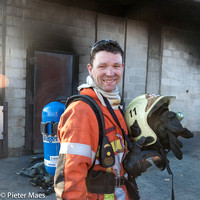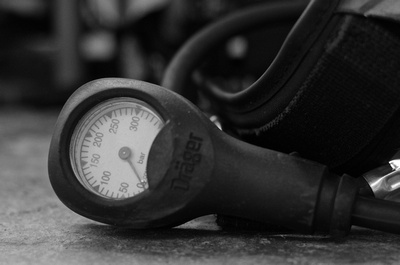Introduction.
Below you can find the third article "Connecting RIT and ICS." It has been written by myself with the help of Karel Lambert. Karel is battalion chief at the Brussels Fire Department (Belgium) and founder of CFBT-BE. The English translation has been reviewed by Ed Hartin, chief at Central Whidbey Island Fire & Rescue (USA) and founder of CFBT-US.
The Phoenix fire department has provided the photographs of the Southwest Supermarktet store fire.
The article will soon be available in Spanish thanks to Juan Carlos Campana
A PDF version of the article is available here.
CONNECTING RIT AND ICS
Table of content
2 “Rapid intervention isn’t rapid”
3 Case Phoenix, Arizona (USA), southwest supermarket store, Brett Tarver.
4 Evaluation of the RIT-concept by the Phoenix fire department.
5 Conclusions from the Southwest Supermarket case.
5.1. Conclusions out of the research done by Steve Kreis and Dr. Ron Perry.
5.1.2 On the level of air management.
5.1.3 On the lever of strategy and tactics. (KREIS, 2003)
5.2 Lessons to learn from the NIOSH report. (NIOSH, 2002)
5.2.1 The events leading to the accident.
5.2.2 The (re-)actions of the victim.
6 Lessons for Europe / other firefighters?
6.1 The European situation and attitude towards this problem.
6.3 ICS, the all-encompassing system?.
7 Back with our feed on the ground…
1. Introduction.
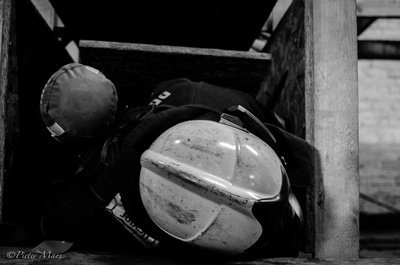 copyright pieter maes
copyright pieter maes In a first article “RIT where to start?” the principles and philosophy from the original RIT concept from the USA were explained. In a second article “Evaluation of a pilot course Fireground Survival, the Mayday and Air Management” we explained why the individual approach is so important when you start with these kind of trainings. This way we have chosen to offer more security to every single firefighter as soon as possible. You maximize your changes for a successful rescue if the firefighters sends out a good mayday in time. Once this step is taken it makes sense to start training on rescue techniques specifically for firefighters in response on a mayday.
In a first article “RIT where to start?” the principles and philosophy from the original RIT concept from the USA were explained. In a second article “Evaluation of a pilot course Fireground Survival, the Mayday and Air Management” we explained why the individual approach is so important when you start with these kind of trainings. This way we have chosen to offer more security to every single firefighter as soon as possible. You maximize your changes for a successful rescue if the firefighters sends out a good mayday in time. Once this step is taken it makes sense to start training on rescue techniques specifically for firefighters in response on a mayday.
With this third article we want to explain that there is an evolution regarding RIT. That lessons are learned. That early mistakes are addressed and that criticism is incorporated in adjusted procedures. But also that we should realize that we have to be ready for that day when a colleague calls out for help with a mayday. That next to individual trainings like Fireground Survival we will also have to train on how to evacuate a colleague. And last but not least, that as an incident commander, you will have to train on receiving a mayday and how to respond. It is one of those calls that you just won’t feel at ease with. It will put your world upside down, you will feel your heart beating in your throat. At such a time you better have a plan ready, to get to work as efficiently as possible.
This article gives a vision on what the ideal answer could be. And this starting from a regrettable accident. But thanks too persistent research and reporting by the Phoenix fire department (Kreis, 2003) and thorough reporting by the NIOSH (NIOSH, 2002) everybody has the opportunity to learn. A tragic accident from the past can help us to all work safer in the future. No fallen colleague would argue against his fellow colleagues learning from his tragic event.
2 “Rapid intervention isn’t rapid”[i]
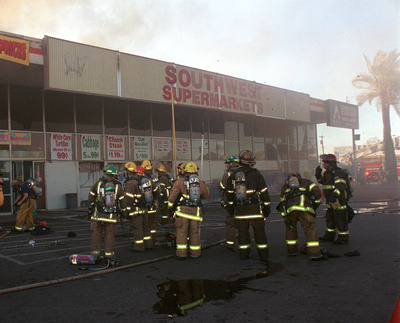 Phoenix fire department, USA
Phoenix fire department, USA What looked like a simple garbage fire in Phoenix, on March the 14th,will develop into a difficult fire in a commercial building. When a firefighter gets in trouble the Rapid Intervention Team is activated. During the search and rescue for the missing firefighter four members of different rescue teams themselves will get in trouble. One of them ends up in critical condition. The missing firefighter will not be evacuated in time and will lose his life, this despite the fact that he was located alive quite quickly a first time. In a time span of little more than 10 minutes he is re-located multiple times by colleagues. But they also will not succeed in evacuating the victim. After the definitive location of the missing firefighter it will still take 19 minutes to get the victim out of the building. During the attempts to rescue the victim 12 extra maydays are being called by firefighters who again get in trouble themselves. There are in the end four more injured firefighters. One of them is evacuated in respiratory arrest but is successfully resuscitated by the paramedics on scene. (NIOSH, 2002)
What looked like a simple garbage fire in Phoenix, on March the 14th,will develop into a difficult fire in a commercial building. When a firefighter gets in trouble the Rapid Intervention Team is activated. During the search and rescue for the missing firefighter four members of different rescue teams themselves will get in trouble. One of them ends up in critical condition. The missing firefighter will not be evacuated in time and will lose his life, this despite the fact that he was located alive quite quickly a first time. In a time span of little more than 10 minutes he is re-located multiple times by colleagues. But they also will not succeed in evacuating the victim. After the definitive location of the missing firefighter it will still take 19 minutes to get the victim out of the building. During the attempts to rescue the victim 12 extra maydays are being called by firefighters who again get in trouble themselves. There are in the end four more injured firefighters. One of them is evacuated in respiratory arrest but is successfully resuscitated by the paramedics on scene. (NIOSH, 2002)
This case raised some questions. Not in the least: “Why did the RIT concept not work?” RIT has his pros and cons. And just like any other new thing it is also subject to permanent evaluation and correction. In the USA this case was the reason for the Phoenix fire department to investigate the effectiveness of RIT. (Kreis, 2003) The results of this research has ensured that the RIT-concept within this fire department was reviewed. The research lead by Steve Kreis pointed out some important problems concerning the original RIT concept. But, when you go through the research done by NIOSH (NIOSH, 2002) some other questions pop up. Questions not on the level of organization, but on the individual level. Questions with answers were every firefighter can learn from.
3 Case Phoenix, Arizona (USA), southwest supermarket store, Brett Tarver.[ii]
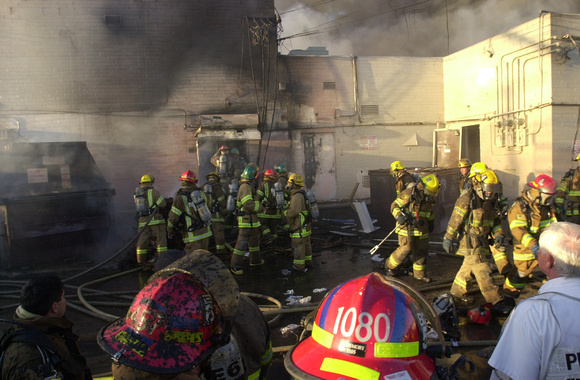 Phoenix fire department, USA
Phoenix fire department, USA
On March the 14th a pile of cardboard against the exterior backside of a commercial warehouse in Phoenix (USA) catches fire. At 16:45 the dispatchers sends out Engine 24 to what looks like a straight forward intervention. Immediately after arriving on scene a problem shows up. High tension cables were hanging directly above the fire. The decision is taken not to start extinguishing with water as long as there is electrical current on the cables. The engine on scene scales up the incident and orders additional resources.
In the meanwhile the evacuation of the warehouse concerned and adjacent buildings is started. Everybody gets out safely including an employee who tried to save some goods at the very latest moment. He will later declare that he had to stop this because he saw flames coming inside through the door. At the door he noticed how flames extended into the roof construction. He was unable to close the door before he evacuated the building. This last fact was not reported to the incident commander on scene.
Upgrading the incident goes quite efficiently and very quickly three engines, a ladder and two Rescues were on the scene together with a battalion chief. At 17:02, E14 arrives on scene. They get the order to enter the building via the front side (Side Alpha) off the building to check if all civilians had left the building and if the fire wasn’t entering the building. This crew was uninformed about the backdoor that the employee had left open.
E14 observes light smoke banked down to about 1,2m (4ft) below the ceiling. When they leave the shop area and enter the storage area in the back of the store they notice thick black smoke and some heat. They decide to go back out and get a handline. They re-enter the building with the hoseline.
In the meantime another engine (E3) receives the order to assume the RIT-function. While doing there 360° to get an overview they report heavy black smoke emitting out from the back side (Side Charlie) of the building. After this the incident commander reassigns them to pull a second handline into the bakery next to Side Charlie to check for fire extension. E3 takes a handline and enters the building through the same entry as E14, the main entrance. Since the fire is extending into the building the incident commander asks the dispatchers to call it a first alarm. This means that extra re-enforcements will be arriving.
At 17:14 three teams are working in de building (Engine 14, Engine 3 and Rescue 3). They are handling two low pressure handlines. In contrary to earlier reports there is now also thick black smoke in the shopping area itself.
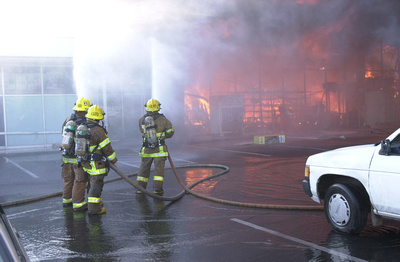 Phoenix fire department, USA
Phoenix fire department, USA
At 17hrs25 the situation is still not improving. The incident commander requested reinforcements for the third time and hestarts preparations to switch from offensive to defensive strategy[1]. By now the heat inside the shopping area is clearly perceptible and black smoke fills up the whole volume down to the ground. The crews from E3 and R3 report seeing flames against the ceiling. The crews from E14, E2 and R3 continue their search for the fire and pull down pieces of the ceiling for this. During these works a member of E14 crew report to his officer that he is low on air. The officer of E14 pulled his men together and told them that they would follow the handline to find their way out. While they are doing this the victim (FF1) will fall together with the firefighter behind him (FF2). Both loose contact with a handline, are disoriented and they will advance in a wrong direction. Quite soon they will realize that they are lost and they will call a mayday. By then the other members of the E14 crew are outside. E3 and R3 are still inside at work.
The incident commander receives the mayday and orders E18 and L9 to assume RIT functions. When the officers of E14 outside notices that he is two men short he also orders two firefighters from E21 to follow the handline inside in search for the missing crewmembers.
Inside the building things aren’t getting better. The two crewmembers that are lost will lose contact. Both will also run out of air. They only started to leave the building when their low-air alarm sounded, meaning they had no more reserve if things would go wrong… One of the two lost firefighters (FF2) picks up radio traffic nearby and is able to find two colleagues that will evacuate him out of the building.
The incident commander mistakenly thinks that the evacuation of FF2 also means the end of the rescue. He orders all fire fighters out of the building to switch to a defensive strategy. The missing firefighter FF1 hears this and at 17:29 he calls once again for help over the radio. He states to have no more air, that he is breathing in air and that he is lying down on the ground.
Not much later, at 17hrs30, the officer of E21 hears screaming nearby the storage room. He goes towards the screaming and finds the lost firefighter (FF1), standing up, not wearing the regulator on his facepiece and nearby the handline. The officer grabs the victim and puts him on the handline to get out of the building. The lost firefighter (FF1) was resistive and appeared disoriented. With a second attempt the officer is succesfull in bringing the lost firefighter onto the handline. The firefighter (FF1) stands up, turns and quickly moved in the opposite direction. The officer tried to grab him to hold him on the handline, but he is unsuccessful.
Subsequently a member of R3 (FF2) hears the voice of the lost firefighter (FF1) and starts looking for him. He finds the firefighter (FF1) a little further into the building, again standing up. The lost firefighter tells the member of R3 (FF2) that he is out of air. The member from R3 tells the firefighter (FF1) to stay calm and to follow him out of the building. The victim (FF1) turns and again walks away into the wrong direction. The member from R3 then grabs the victim and tells him they should go the other way. The victim turns away and by doing this he knocked down the member of R3. Because of this they lose contact. The member of R3 tries to find the victim back but runs out of air himself and has to leave the building. Another firefighter (FF3), who was about to leave the building low on air, hears the voice of the victim (FF1) from inside the building. The firefighter (FF3) turns back and goes inside the building. He also will locate the victim (FF1) and make contact with the victim. At 17hrs34 FF3 radios to the incident commander that is with the victim (FF1) and that they both are out of air. The victim’s PASS (personal safety alarm) was not yet activated at that time.
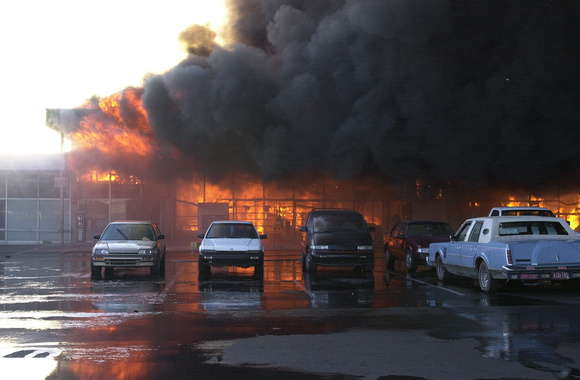 Phoenix fire department, USA
Phoenix fire department, USA Once again extra crews enter the building. They are now searching for the two missing firefighters (FF1 + FF3). The officer of E25 quickly finds a firefighter (FF3) on the ground near the production unit. He sends out a radio message that he found the injured firefighter (FF3) and that he needs assistance to evacuate him. The crew of his engine hears this and go to help their officer. His crew bring the injured firefighter (FF3) out of the building. Just before his evacuation the injured firefighter (FF3) is evacuated and he is able to say to the officer that the victim (FF1) had to be nearby. Outside the firefighter recognize the injured firefighter as FF3. At that point the incident commander also realizes that the original victim is still inside.
Once again extra crews enter the building. They are now searching for the two missing firefighters (FF1 + FF3). The officer of E25 quickly finds a firefighter (FF3) on the ground near the production unit. He sends out a radio message that he found the injured firefighter (FF3) and that he needs assistance to evacuate him. The crew of his engine hears this and go to help their officer. His crew bring the injured firefighter (FF3) out of the building. Just before his evacuation the injured firefighter (FF3) is evacuated and he is able to say to the officer that the victim (FF1) had to be nearby. Outside the firefighter recognize the injured firefighter as FF3. At that point the incident commander also realizes that the original victim is still inside.
While the incident commander gives the order to everyone to leave the building the officer from E25 (FF4) finds the injured FF1. The victim (FF1) is lying unconscious on the ground and his PASS alarm is activated now. The officer who found the victim sends out a first mayday but it won’t be heard. A second mayday at 17:40 will be picked up. In response to this mayday again extra crews are ordered into the building in search of the officer (FF4) and the original victim (FF1). In that time the officer of E25 runs out of air and he takes his facepiece of. He tries to crawl outside. Crewmembers from E6, searching for their colleagues, will hear a PASS-alarm sounding and go towards it. They first find the injured officer (FF4), but his PASS-alarm was not activated. Crewmembers from E710 evacuate FF4 and the crew from E6 continues to search for the first missing firefighter (FF1). Thanks to his activated PASS alarm the crew can find the victim (FF1) and they can start with the evacuation out of the building. This evacuation turns out to be a lot more difficult than expected. The unconscious firefighter is 1,92m tall (6ft and 4 inches) ad he weighed about 131 kilograms (289 pounds). On top of that there was also the weight of his turn out gear. It will take another 19 minutes before the unconscious firefighter (FF1) is out of the building.
4 Evaluation of the RIT-concept by the Phoenix fire department.
As said, the described case raised quite some questions concerning the effectiveness of the RIT-concept applied in the Phoenix fire department at that time. It is fair to say that this concept was identical of very similar in most US fire departments. The Phoenix fire department decided to launch a thorough research project to investigate the effectiveness of their RIT-procedure in a similar situation.
Led by Steve Kreis and with the cooperation of Dr. Ron Perry the Phoenix fire department started to investigate if it was realistic to safe a firefighter using the RIT-procedure that was used by the Phoenix fire department. Two scenarios were set up in three different buildings similar to the situation in the Southwest supermarket store in Phoenix. The drills were conducted in three vacant single-story commercial occupancies spread out over the Phoenix metro area. The owners of the structures donated or leased the buildings to the department. The occupancies included the following:Melrose Bowl, a large bowling alley in central Phoenix. The interior of this site was partitioned off to limit the size of the structure to about 7,500 square feet. One hundred fifty-two crews participated at this location.
- Melrose Bowl, a large bowling alley in central Phoenix. The interior of this site was partitioned off to limit the size of the structure to about 7,500 square feet. One hundred fifty-two crews participated at this location.
- The Coyote Grill, a 5,000-square-foot bar and restaurant in south Phoenix. Forty-three crews participated at this location.
- The Watering Hole, a 5,000-square-foot bar and restaurant in north Phoenix. Seventy-four crews participated at this location.
More than 200 scenario evolutions are performed by firefighters from the Phoenix fire department. The results of this research formed the base for the article “Rapid intervention isn’t rapid” by Steve Kreis (Kreis, 2003).
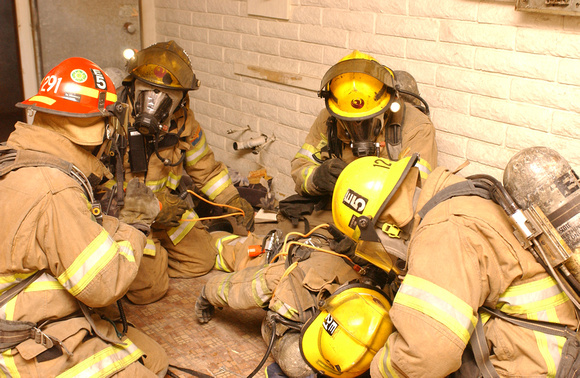 Phoenix fire department, USA4/3/02
Phoenix fire department, USA4/3/02
Phoenix Fire crews train on Rapid Intervention Crew operations at the Coyote Grille in South Phoenix. Without having seen the inside of the Structure, darkened masks and only a hoseline to follow, the crews search for a downed FF. The training is designed to give crews a better sense of a real fire without the danger.
In total 1444 firefighters participated in the scenarios. One scenario meant that 2 firefighters with a low pressure handline would advance 30m (100ft) into a building. They would get in trouble, get lost and will send out a mayday. The first firefighter in trouble is still mobile and has contact with the handline. The second firefighter in trouble is lying unconscious on the ground 11m (36ft) away from the handline. The PASS-alarm from the unconscious firefighter is activated. The first (still conscious) firefighter has a radio and is able to communicate over the radio. Subsequently the Rapid Intervention Team (RIT) with 4 members started the search to locate and evacuate the two missing firefighters. Once the first firefighter was found two members of the RIT had to evacuate him. The other two members of the RIT have to continue their search for the other missing firefighter. Once the second firefighter is found they have to evacuate him too.
Nothing was added to hamper the search or the rescue. The handline was stretched out correct with no loops, kinks,… The victims were not stuck in cables or debris. Some boxes in the form of cubes were added from wooden pallets. But the handline could always easely go around these. In short, this looked like an easy straight forward job. You could think about it as a ‘grab and run’. Only difficulty was the low visibility. This was variable between 1,5m and 6m (5ft and 20ft).
The Rapid Intervention Teams were able to locate and reach the firefighters in trouble within eight to nine minutes. This is within expectations. Especially if you take into account that it took the teams [2:55] (2min55sec) on average to start their search. That means that after 5:30 (5min30sec) of effective searching they found the firefighters. It also was clear that once the first firefighter was located, the second firefighter was located almost immediately after that. As good as no time was lost here. This part of the search and rescue went rather smooth and within expectations.
The evacuation of the first firefighter also went easy and quick without remarkable problems. But the evacuation of the second firefighter, who was unconscious, didn’t go at all as expected. On average it took 21,8 minutes to locate and evacuate this firefighter. (Kreis, 2003) This fact explains also why one out of five rescuers will get in trouble himself. The cylinders that are used by the Phoenix fire department only carry air for 18,5 minutes (+- 30%). The bottles are only filled up to 200 bar.[2] And this while it took 21,8 minutes of hard work to get the unconscious firefighter outside. With the RIT-strategy used by the Phoenix fire department, at that time, it was almost impossible to go and help a firefighter without the rescuers themselves getting into trouble.
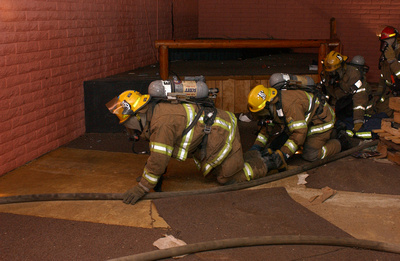 Phoenix fire department, USA4/3/02
Phoenix fire department, USA4/3/02
Phoenix Fire crews train on Rapid Intervention Crew operations at the Coyote Grille in South Phoenix. Without having seen the inside of the Structure, darkened masks and only a hoseline to follow, the crews search for a downed FF. The training is designed to give crews a better sense of a real fire without the danger. And a second problem was discovered. The research in Phoenix showed that a firefighter in most cases only started to go outside when his low air alarm got activated. At the Phoenix fire department this happened at 48 bar. In the Phoenix research it is assumed that a firefighter consumes 12 bars per minute. This on the high side and it leaves only four minutes of time to get outside. In other countries this can be slightly different. For example in Belgium we assume that a firefighter has 9 minutes of active time left on his low air alarm. Being firefighter and assuming that once your low air alarm sounds you still have enough time to get outside is like playing Russian roulette. Especially if commercial buildings are involved.
And a second problem was discovered. The research in Phoenix showed that a firefighter in most cases only started to go outside when his low air alarm got activated. At the Phoenix fire department this happened at 48 bar. In the Phoenix research it is assumed that a firefighter consumes 12 bars per minute. This on the high side and it leaves only four minutes of time to get outside. In other countries this can be slightly different. For example in Belgium we assume that a firefighter has 9 minutes of active time left on his low air alarm. Being firefighter and assuming that once your low air alarm sounds you still have enough time to get outside is like playing Russian roulette. Especially if commercial buildings are involved.
It shouldn’t be a surprise that during the scenario’s one out of fire rescuers effectively got in to trouble himself. ‘In trouble’ meant a whole range of things: coming outside on a low air alarm, getting disoriented and many other smaller and bigger problems. On a meeting afterwards Chief Alan Brunacini gave probably one of the best descriptions of our reality: “Our life expectancy when entering a building on fire is limited by the air we carry with us.”
The fact that we are not carrying enough air in ours cylinders to complete a rescue means that we have to rotate the crews. It was found that to complete the rescue of one conscious and one unconscious firefighter in a safe way 12 firefighters were needed. Which is three times more than the original four…
On the side of all this there are some remarks to be made. In the scenario’s there was no heat or other things adding stress. The evacuations had to be done horizontally, there were no stairs to climb or go down. In short, it wasn’t that complicated as a scenario. In real life it will probably take quite a bit longer to evacuate a firefighter. And that is also what was noticed at the Southwest supermarket fire which was the direct reason for this research.
There are a number of important conclusions resulting from analysis of this incident. (NIOSH, 2002)
5 Conclusions from the Southwest Supermarket case.
5.1. Conclusions out off the research done by Steve Kreis en Dr. Ron Perry.
The research of the Phoenix fire department focuses especially on the RIT-operation in itself. Dr. Ron Perry has evaluated the results of the research to asses the effectiveness of a RIT-operation. Steve Kreis adds some conclusions in his article (Kreis, 2003). These conclusions cover four aspects: time, available air (cylinder), used resources and coordination. The conclusions[3] concerning the applications of the RIT-concept as done at the time within the Phoenix fire department are:
5.1.1 Concerning time.
- It will take between 8 to 9 minutes to localize two firefighters who advanced 30 to 40m (100ft to 130ft) into a building.
- Once located it will take 10 to 12 minutes to evacuate an unconscious firefighter horizontally out of a building if he is found 30 to 40m (100ft to 130ft) into a building.
- A total RIT operation (locating + evacuation) will take 21 minutes (total of first two conclusions) and most likely it will take more time.
- On a average the cylinders of the Phoenix fire department (with 200 bar) only provide a firefighter with air for 18,5 minutes (+- 30%)
5.1.2 On the level of air management.
- On average a firefighter will not have enough time to complete a whole RIT-operation.
- Firefighters have the reflex or habit to only turn around and start to return, when their low air alarm is activated. This is too late. Assuming that the low air alarm is a return-signal is fundamentally wrong. An air management officer or commander must order the men to leave the building before the low air alarm is activated.
5.1.3 On the lever of strategy and tactics.
- With a mayday call you get a second intervention in the first intervention. As a consequence you need more manpower on the incident command level. At least one extra officer / commander should be responsible for the RIT operations. Ideally he even has two assistants: a sector commander and a technical rescue assistant.
- Multiple crews will be needed (up to 12 firefighters) to bring the RIT operation to an end. Enough reinforcements need to arrive as quickly a possible on scene.
- The RIT-commander must use a strict accountability system so that he knows at any time who is were.
- Firefighters are result oriented persons. It is necessary that they understand that they are just one part of a bigger operation. So they should only do their share of the task, depending on their air supply. If they do not do this the whole operation is in danger.
Based on the above conclusion Steve Kreis formulates a correct remark: “Rapid intervention isn’t rapid.” He states that the only real solution is to make sure that you don’t get into trouble. 75% of training time should be spent at the prevention of accidents. 25% of the training time can be spent at how a firefighter can save is own (self-rescue), he writes.
The statement of Steve Kreis (and many others): “You simply shouldn’t get yourself into trouble.” Asks us to review this problematic also from a different angle, being the individual level of skills of every firefighter. This we can do bases on the NIOSH report that tells us step by step the actions of the firefighters.
5.2 Lessons to learn from the NIOSH report. (NIOSH, 2002)
Thanks to the NIOSH report we can also read step by step how the firefighters acted. This goes about individual skills of every firefighter. And there are some remarkable observations to make. The quoted parts of a sentence are literally taken out of the NIOSH report.
5.2.1 The events leading to the accident.
- When the first crew in decides to turn back and go outside (quote) “”As they were following the handline out of the produce storage area the victim and the firefighter following him fell over some debris and became separate from the handline.” This means that they were walking standing up with unsufficient visibility to adequately see where they were going. It is recommended in such situation to stay low and move on to crawl. Visibility often will be better, you are more stable (four points of support) and you fall (stumble) will be less serious.
- After falling they lost contact with the handline. After this they stand up again and (quote) “the victim and firefighter from E14, both back on their feet, walked into a wall and fell again.” So despite the poor visibility the firefighters again didn’t have the reflex to stay low. Moving low would possibly have avoided falling once again. Also it is more likely to find the handline back when you are moving low on hands and feet.
- The victim will lose his self-control and his colleague has to grab him to keep hold of him. This is the first rescue of the victim by a colleague. The colleague had to hold on to the victim and try to calm him down. After that both firefighters manage to send out a quality mayday. Their location is right away linked to their ‘last know location’, being on the handline. But after calling the mayday both firefighters will move and still loose contact with each other. The victim will move further into the building, the colleague will back track in the right direction. The colleague hears noise from radios from other colleagues and moves toward this. This will eventually save him.
5.2.2 The (re-)actions of the victim.
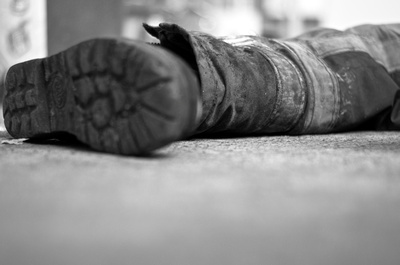
 The question if a rescue operation for a colleague firefighter will be successful or not is not only answered by the actions of the Rapid Intervention Team. The victim himself, the firefighter in trouble, can also play a determining role with his (re)-actions.
The question if a rescue operation for a colleague firefighter will be successful or not is not only answered by the actions of the Rapid Intervention Team. The victim himself, the firefighter in trouble, can also play a determining role with his (re)-actions.
In total the victim will be located and / or helped six times by colleagues. Each time the aim is to rescue the colleague. The reactions of the victim are confused, irritated and hamper in an important way his rescue.
It is important to say that we do not know why the victim acted in this way and what his reasons were. Without doubt his believe was that he was doing the right thing. It is reasonably that extreme stress, disorientation, chaotic conditions,… all together just made very hard to keep a clear and focused mind. This can happen to any firefighter that enters a building on fire. It is important to dear to look at this and think about it. So that maybe you can learn from it and that these lessons can save you and other firefighters a next time. We can avoid tragic accidents by looking at the past.
- A first time his direct crewmember will try to calm him down. Despite this they will loose contact with each other.
- The second time that the victim is found by a colleague this colleague was going towards screaming he could hear from the victim. He found the victim standing up with his regulator disconnected. Twice the victim will be put on the handline low to the ground. But each time the victim will stand up and wander off in the wrong direction. After the second attempt the rescuer himself was so low on air that he had to save himself by getting out of the building.
- A third time the victim is again found by a colleague that heard screaming and moved towards it. The victim was still standing up. The colleague tries to give advice to the victim to get to safety but he seems to ignore this and again he will wander off deeper into the building. The colleague will stop the victim physically and will try to drag him into the right direction. The reaction of the victim on this makes that the rescuer falls and has to stop his attempts to save his colleague.
- The fourth time the victim was found a colleague that was just about to leave the building heard the victim’s voice. Despite his almost empty cylinder he decides to go towards the person he heard. He finds the victim on the ground, out of air, his PASS alarm not activated. The rescuer calls a mayday and soon after he will get in trouble himself due to lack of air. He is rescues and can report to his rescuers were the victim is.
- Following the direction of the fourth firefighter that found the victim he is quickly found back by a colleague that continued searching after the rescue of the other firefighter. He finds the victim unconscious on the ground. This rescuer also ends up low on air and sends out a mayday. He can’t continue with the evacuation of the victim due to lack of air.
- The victim is finally found a sixth time by colleagues that respond to the mayday of the fifth firefighter – rescuer. They find the rescuer and quickly locate the unconscious victim for the sixth time. It is only now that the evacuation of the first victim starts.
6 Lessons for Europe / other firefighters?
In Belgium or Europe we have hardly or no procedures for a firefighter in trouble. Let alone that crews would be trained in responding to a firefighter mayday call. This is quite worrying and not without reason. But it also gives the opportunity to learn from experience and know how in other countries. In the USA the Rapid Intervention Team (RIT) concept is being used since the beginning of the 90’ies. Then in 2001 there is the tragic accident in the Southwest supermarket store in Phoenix and in 2002 the NIOSH report (NIOSH, 2002) is published followed by the article from Steve Kreis “RIT isn’t rapid” (Kreis, 2003). Besides these publications there are by now many more publications that can be found online concerning the RIT-concept.
Thanks to the work done and the experiences from the USA, Europe has a unique opportunity to work out a thoughtful procedure ‘firefighter mayday’. And this on the level of incident command (strategy / tactic) as on the level of every individual firefighter (skills).
6.1 The European situation and attitude towards this problem.
Every incident commander and officer wants to guarantee the safety of his men during any intervention. For the biggest part this happens by evaluating the situation constantly, reading the smoke, taking the wind into account, balancing resources versus the fire… In short, any possible parameter that can determine the fire behavior has to be looked at. In daily life in Belgium firefighter will use the GRSTV-model for this. Some other countries have similar systems. The aim is twofold. On one side it can help you to get the fire under control as rapid as possible and on the other side it will help you to do this with a minimum of risk for your crews. This approach is mainly preventive. We try to ‘read the fire’, to estimate how it will evolve and thus be able to go for that window of opportunity to safely tackle the fire.
This approach is based mainly on knowledge typical for the fire services in Western Europe. The idea that, because of the typical unpredictable character of an accident, a firefighter might still get in trouble is as good as a taboo in Western Europe.
As a consequence the scenario of a firefighter calling a mayday is neither on the level of skills, nor on a tactical or strategic level taken into account. A firefighter in trouble seems not to exist… There is no reactive scenario that is ready to use when one of our colleagues gets in trouble. Even worse, a so called ICS (Incident Command System) is non existing. During interventions we have to make do with what we think is right and available. On the level of personal skills there is an evolution in Belgium with the Fireground Survival training and Air management. We can only welcome this. But on the level of an ICS we really need to start from scratch.
You can train your crews to their best and prepare them for everything, if there is no efficient coordination, no effort and no clear strategy all the individual work and skills will be lost.
Every incident commander should have dare to ask the question what the optimal strategy or tactic is when tomorrow a colleague (and friend?) calls a mayday over the radio. Out of the research in the USA we can learn that a separate RIT, standing by, isn’t necessary the right answer. So maybe we have to look at other options. On the other hand we can learn out of the reports that the (re)actions of the individual firefighters in trouble often are decisive for the successful outcome of the rescue.
That gives us two domains to work on: the individual skills of every single firefighter and the incident command level. Every firefighter should above all know what he has to do when he gets in trouble. This is included in the Fireground Survival, air management and mayday training. The Phoenix case shows in a tragic way how wrong reflexes of a firefighter can wipe away multiple changes to be rescued. Preparing yourself for crisis situations will make a difference in these conditions. Training and practice on a mental and physical level are thus the responsibility of every firefighter.
On the level of the incident command system (ICS) we have nothing yet in Belgium. A major problem is that there is no uniform system in which you could integrate a “mayday procedure”. In Belgium, as in many European countries, there is no full ICS. And yet out of the Phoenix case it is clear that efficient incident command with the ability to scale up fast and adequate is crucial. Only then a RIT-concept can be integrated in the ICS. Once this integration is completed we can even step away from the idea that we need separate teams on standby only for the RIT-function. Even stronger, the Phoenix case learns teaches us that we shouldn’t do this because a classic RIT won’t work quite often. A Rapid Intervention Team has to be so ‘rapid’ that a team from the outside will quite often come too late. We should consider other tactics.
6.2 Merging RIT and ICS?
If we leave behind the idea of a separate RIT on standby for the firefighter mayday, we also have to ask the question which resources are available to go and help a colleague? And how will we do this efficiently?
The answer is possibly to be found in the NIOSH report about the Phoenix case. The victim will be found up to 6 times by a colleague. But only the last two times this will be by a crew that entered the building specifically looking for the victim. The first four times that the victim was located was b firefighters that happened to be nearby and who heard the victim. Several of the firefighters who tried to rescue the victim and ended up in trouble themselves got saved by moving towards colleagues they heard nearby.
It is fair to say that the assignment of a firefighter can change to ‘assisting a colleague in trouble’ when he is the closest to the firefighter in need of help. This is the quickest possible reaction and answers the need to race against the clock when you have to go and rescue one of our own.
But this approach has some consequences. On the one hand for every individual firefighter and the skills he needs to master. We will have to give our crews additional training in responding to a mayday. On the other hand for the incident commanders and their strategy and tactics. If your crews on the fire ground are reassigned to another more urgent task, then other crews will have to move in to fill up the original assignment of the first crew. A system that allows easy and smooth rotating of crews is needed.
In fact we are speaking about a full worthy Incident Command System. An ICS is a standard scheme that an incident commander can use to manage an intervention. Based on certain parameters specific decisions will be taken who again lead to standard reflex-actions concerning the resources that come available.
In the USA ICS’s are well established. A nice example is how an intervention is scaled up. Fires are classified as a first alarm, second alarm, third alarm,… To each of these alarms a certain amount of resources (crews, commanders, vehicles,…) is linked.
A dispatcher will based on the info he receives estimate what kind of fire is called in. He then classifies the fire and dispatched the resources linked to the alarm he classified the fire under. This way an incident commander knows always what resources he will have available for lets say a second alarm. Up to this level we can cope in Europe based on our standard numbers of vehicles responding to a fire. The advantage of an ICS becomes really clear when the incident commander on scene decides that he needs more resources on scene. With a good ICS he can then simply call a higher alarm. For example he can go from second to third alarm, or even jump in one time to fourth alarm. The dispatcher that receives this call knows what the specific reflex-actions are linked to the given alarm. He can send out right away the expected resources. In other words, with no more then two words and a minimum of time a predefined amount of resources will be dispatched to the fire ground.
Also typical for an ICS is that the arriving vehicles will stop at a ‘staging area’ and report there. This is what in some countries is called a ‘Rendez-vous’-point where you announce your arrival and remain on standby for the incident commander. The incident commander has the opportunity to quickly (two words) ask and receive a predefined amount of resources on the fire ground. If needed this will include extra commanders that can support the incident commander providing this is written down in the ICS. It is a very efficient way of managing the resources on your fire ground.
6.3 ICS, the all-encompassing system?
ICS is a tool. It is not a theoretical approach of a fire. It is a roadmap, a scheme that an incident commander should know and that he has to be able to use for the situation at hand. The standardized and developed ICS will result in an incident commander that can have a better focus on tactical and strategic decisions that he has to make on the fire ground itself without having to work through logistical issues.
Besides different procedures for all kinds of fire (high rise, industrial,…) there is within ICS also room for specific orders or commands. For example in the USA there is a command “give me a ‘PAR’”. PAR stands for Personnel Accountability Report. When an incident commander ask a PAR he expect every officer to report ASAP with a message that confirms that his crew is safe and sound. The goal is to determine on a standardized and unambiguous way whether all firefighters are accounted for or not. And if not, to know who is missing.
One of the situations that are more easily to manage with a good organized ICS is a mayday call from a colleague (and friend) in trouble. At that moment you get a second intervention within the first intervention. The level of stress will significantly increase for everyone on the fire ground. Some things will be needed to be done (whether or not simultaneously). As an example:
- The incident commander (IC) has to confirm the mayday and try to localize it as accurately as possible. .
- The IC will (re-)assign if possible the crew closest to the mayday to locate the firefighter that called the mayday and providing first assistance.
- If there is any doubt a PAR will be asked by the IC to rule out or confirm the mayday with absolute certainty.
- The crew going to assist the firefighter in trouble has to be replaced on its first assignment with the crew on stand by as provided in the ICS.
-
The incident will be scaled up to an alarm “firefighter mayday” and the dispatch will immediately send out the necessary resources linked to this alarm. If we take the research form Steve Kreis into account this means:
- A minimum of 12 extra firefighters.
- At least one extra IC, but preferably 3. S
- The tactics and resources on the fire ground shift from tackling the fire to securing the area where the firefighter in trouble is thought to be.
It is obvious that if he incident commander can’t call for extra resources with a simple command (ex. “Dispatch we have a ‘firefighter mayday’ alarm”) it becomes an almost impossible task to scale up fast and efficiently. Also checking if all other crewmembers are safe and sound can be done by a simple “PAR”. We can’t tell how we would do this in Belgium if for say four crews are working on the fire ground. We have no similar order or procedure.
It is important to make a clear and strict remark that during the operations to save a colleague every firefighter remains responsible for his own safety. If every firefighter personally isn’t capable to fulfill his part of the assignment, then this will compromise the whole mission. Before you know it you have multiple firefighters calling their mayday… and that has dramatic consequences for the rescue of the first firefighter asking for help.
A strict ICS is indispensable in these situations. Out of the research done in Phoenix ist became clear that firefighters consistently work too long on a cilinder and decide too late to go out. This is the main reason why members or RIT’s got into trouble. The crews were in other words to focused on the task instead of the result without realizing that a crew is just a part of a bigger system. It is up to the commanders outside to make sure that every firefighter working with SCBA is ‘tracked’ from the outside. He is followed on a distance for ex over the radio. At certain times his cylinder pressure will be asked and at the right time the order will be given to turn back and come out of the building. A firefighter coming out of the building with his low air alarm sounding decided too late to turn around. Even when it is about saving a colleague.
But this approach demands an ICS with a place for a commander who can install an effective air management policy. He tracks crews working with SCBA and has the authority to order them to turn around and leave the building. You are living a dream if you believe that one commander can manage all this. This again shows why standardized to scale up an incident are so interesting. Once an incident commander gives the ‘firefighter mayday’ alarm he knows thas as soon as possible one or more extra commanders will be supporting him.
Such systems improve without a doubt the safety of the crews engaging into a fire and will make the intervention more efficient.
7 Back with our feet on the ground…
Sadly enough we need to admit that an ICS with an integrated mayday procedure wont be for tomorrow. Scaling up and asking for reinforcements is in Belgium a time-consuming and complicate procedure. Both for the incident commander and for the dispatcher. And almost every time this must happen when the stress is mounting and time-pressure is on the rise. It would benefit the functioning of the fire services on the fire grounds if we would have a district crossing standard operating procedures.
And surely, when the shit hits the fan, and a colleague calls for help (or colleagues) every incident commander just wants to push one alarm button. After which the cavalry is coming as soon as possible to assist him to do the maximum for the firefighter in trouble.
Even with the introduction of Fireground Survival in Belgium we still have a long way ahead of us. But the first steps are being taken. When every firefighter knows how he can / must react when getting in trouble, when every firefighter can transmit a good quality mayday,… then it would be extremely regrettable if there is no strong ICS in place to adequately respond to the colleague who is calling for help and maybe fighting for his life.
The fire service is a unique environment to work in. We form a sort of family, a brotherhood. Let’s assure that we can take care of each other, even when things turn ugly. Because as of today we are living with hope. Hope that it will not happen the day of tomorrow…
[1] An offensive attack / strategy is an aggressive interior attack to save as much as possible (people, goods,…). The defensive attack / strategy means that the situation is considered lost and the fire will be allowed to burn in a controlled matter. There are no longer is interior operations. The focus shifts to avoid extension of the fire and protecting adjectand buildings.
[2] In some countries cilinders get filled with higher pressures. For example up to 300 bar in Belgium. This will add time and lengthen the autonomy of a firefighter on one cilinder. Also: there are larger cylinders used in the United States as well.
[3] It should be remembered that the scenario’s for this research were run in vacant commercial buildings as described under “4.Evaluation of the RIT-concept by the Phoenix fire department.”, p 6.
I “Rapid intervention isn’t rapid.” Door Steve Kreis, 12/01/2003 op http://www.fireengineering.com
II NIOSH fire fighter fatality investigation, 25 juli 2002, investigative report #F2001-13, “Supermarket fire claims life of one career fire fighter and critically injures another career fire fighter, Arizona USA”.
